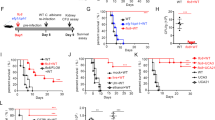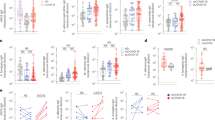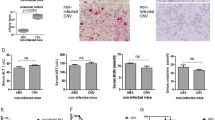Abstract
Neonates are highly sensitive to infections because they are biased to develop Th2 immune responses. When exposed to certain agents, such as DNA vaccines or CpG DNA motifs, neonates are capable to mount adult-like Th1 protective responses. This study investigates the capacity of Candida albicans (C. albicans) dsDNA to induce host resistance in newborn mice against gastrointestinal C. albicans infection. The protective properties of dsDNA are related to an increased number of spleen CD4+ T cells secreting IFN-γ. In infected DNA-treated mice, an enhanced production of IFN-γ by Peyer’s patch cells was observed together with reduced colonization and histopathological changes in the stomach. Our results indicated that C. albicans dsDNA administration in neonates elicited the protective immune response against gastrointestinal Candida infection.




Similar content being viewed by others
References
Albertson GD, Niimi M, Cannon RD, Jenkinson HF. Multiple efflux mechanisms are involved in Candida albicans fluconazole resistance. Antimicrob Agents Chemother. 1996;40:2835–41.
Arancibia SA, Beltran CJ, Aguirre IM, Silva P, Peralta AL, Malinarich F, et al. Toll-like receptors are key participants in innate immune responses. Biol Res. 2007;40:97–112.
Elkins KL, Rhinehart-Jones TR, Stibitz S, Conover JS, Klinman DM. Bacterial DNA containing CpG motifs stimulates lymphocyte-dependent protection of mice against lethal infection with intracellular bacteria. J Immunol. 1999;162:2291–8.
He B, Qiao X, Cerutti A. CpG DNA induces IgG class switch DNA recombination by activating human B cells through an innate pathway that requires TLR9 and cooperates with IL-10. J Immunol. 2004;173:4479–91.
Sun S, Beard C, Jaenisch R, Jones P, Sprent J. Mitogenicity of DNA from different organisms for murine B cells. J Immunol. 1997;159:3119–25.
Rupp S. Interactions of the fungal pathogen Candida albicans with the host. Future Microbiol. 2007;2:141–51. doi:10.2217/17460913.2.2.141.
Kellermann SA, McEvoy LM. The Peyer’s patch microenvironment suppresses T cell responses to chemokines and other stimuli. J Immunol. 2001;167:682–90.
Nagata S, McKenzie C, Pender SL, Bajaj-Elliott M, Fairclough PD, Walker-Smith JA, et al. Human Peyer’s patch T cells are sensitized to dietary antigen and display a Th cell type 1 cytokine profile. J Immunol. 2000;165:5315–21.
Yoshida T, Hachimura S, Ishimori M, Kinugasa F, Ise W, Totsuka M, et al. Antigen presentation by Peyer’s patch cells can induce both Th1- and Th2-type responses depending on antigen dosage, but a different cytokine response pattern from that of spleen cells. Biosci Biotechnol Biochem. 2002;66:963–9. doi:10.1271/bbb.66.963.
Bistoni F, Cenci E, Mencacci A, Schiaffella E, Mosci P, Puccetti P, et al. Mucosal and systemic T helper cell function after intragastric colonization of adult mice with Candida albicans. J Infect Dis. 1993;168:1449–57.
Dimitrova P, Yordanov M, Danova S, Ivanovska N. Enhanced resistance against systemic Candida albicans infection in mice treated with C. albicans DNA. FEMS Immunol Med Microbiol. 2008;53:231–6. doi:10.1111/j.1574-695X.2008.00421.x.
Yordanov M, Dimitrova P, Danova S, Ivanovska N. Candida albicans double-stranded DNA can participate in the host defense against disseminated candidiasis. Microbes Infect. 2005;7:178–86. doi:10.1016/j.micinf.2004.10.011.
Pfaller MA. Nosocomial candidiasis: emerging species, reservoirs, and modes of transmission. Clin Infect Dis. 1996;22:S89–94.
Adkins B, Bu Y, Cepero E, Perez R. Exclusive Th2 primary effector function in spleens but mixed Th1/Th2 function in lymph nodes of murine neonates. J Immunol. 2000;164:2347–53.
Magram J, Sfarra J, Connaughton S, Faherty D, Warrier R, Carvajal D, et al. IL-12-deficient mice are defective but not devoid of type 1 cytokine responses. Ann N Y Acad Sci. 1996;795:60–70. doi:10.1111/j.1749-6632.1996.tb52655.x.
Romani L, Mencacci A, Cenci E, Spaccapelo R, Del Sero G, Nicoletti I, et al. Neutrophil production of IL-12 and IL-10 in candidiasis and efficacy of IL-12 therapy in neutropenic mice. J Immunol. 1997;158:5349–56.
Bot A, Casares S, Bot S, von Boehmer H, Bona C. Cellular mechanisms involved in protection against influenza virus infection in transgenic mice expressing a TCR receptor specific for class II hemagglutinin peptide in CD4+ and CD8+ T cells. J Immunol. 1998;160:4500–7.
Ito S, Ishii KJ, Gursel M, Shirotra H, Ihata A, Klinman DM. CpG oligodeoxynucleotides enhance neonatal resistance to Listeria infection. J Immunol. 2005;174:777–82.
Romani L, Cenci E, Mencacci A, Spaccapelo R, Grohmann U, Puccetti P, et al. Gamma interferon modifies CD4+ subset expression in murine candidiasis. Infect Immun. 1992;60:4950–2.
Cenci E, Romani L, Vecchiarelli A, Puccetti P, Bistoni F. T cell subsets and IFN-gamma production in resistance to systemic candidosis in immunized mice. J Immunol. 1990;144:4333–9.
Ashman RB, Farah CS, Wanasaengsakul S, Hu Y, Pang G, Clancy RL. Innate versus adaptive immunity in Candida albicans infection. Immunol Cell Biol. 2004;82:196–204. doi:10.1046/j.0818-9641.2004.01217.x.
Acknowledgment
This work was supported by a project Actions Concertees Interpasteuriennes (ACIP) No A/7/2005.
Author information
Authors and Affiliations
Corresponding author
Rights and permissions
About this article
Cite this article
Remichkova, M., Danova, S., Tucureanu, C. et al. Effect of Candida albicans dsDNA in Gastrointestinal Candida Infection. Mycopathologia 167, 333–340 (2009). https://doi.org/10.1007/s11046-009-9185-9
Received:
Accepted:
Published:
Issue Date:
DOI: https://doi.org/10.1007/s11046-009-9185-9




